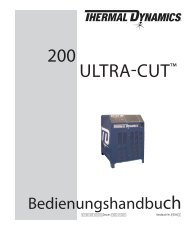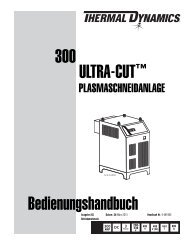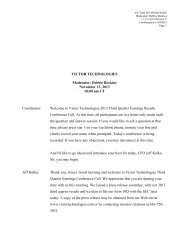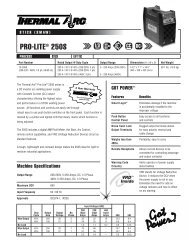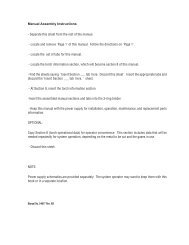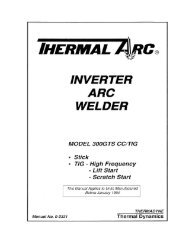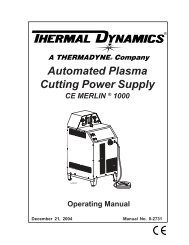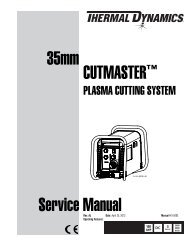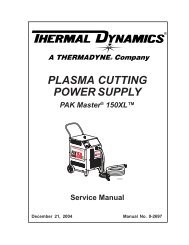Automation Operator's Ready Reference, 63-2824 - Victor ...
Automation Operator's Ready Reference, 63-2824 - Victor ...
Automation Operator's Ready Reference, 63-2824 - Victor ...
Create successful ePaper yourself
Turn your PDF publications into a flip-book with our unique Google optimized e-Paper software.
Operator’s <strong>Ready</strong> <strong>Reference</strong>
What is plasma?<br />
Plasma is a gas heated to an extremely high temperature and ionized so that it becomes<br />
electrically conductive. Plasma arc cutting uses the plasma as an electrode to transfer a<br />
electrical arc to the work piece. The heat of the arc melts the work piece and the force of the<br />
plasma and shield gases blow away the molten metal to cut the work piece.<br />
Different metals react differently to plasma cutting. Carbon steel can be oxidized, and is usually<br />
cut with a plasma containing oxygen to take advantage of the exothermic process. Higher<br />
levels of oxygen in the plasma result in higher heat and higher rates of oxidation. The result is<br />
a faster and cleaner cut. Stainless steel and aluminum are not subject to rapid oxidation and<br />
depend entirely on the plasma’s heat for the cutting process. Because plasma produces much<br />
higher heat than the oxygen-fuel cutting process, plasma can cut stainless steel and aluminum<br />
quickly and cleanly.<br />
Choosing a plasma process<br />
Thermal Dynamics systems offer a variety of plasma cutting processes for precision and general<br />
purpose cutting. Ultra-Cut systems offer precision cutting as well as conventional cut options.<br />
Auto-Cut ® O 2 systems offer high speed oxygen cutting, precision non-ferrous and conventional<br />
cut options. Auto-Cut systems offer conventional mild steel and precision non-ferrous options.<br />
Plasma Shield<br />
O2<br />
Process<br />
Air<br />
Mild Steel Precision 50-300 Amps<br />
and High Speed Oxygen Process<br />
Weld <strong>Ready</strong> Cut Surface<br />
O 2 O 2 Mild Steel Precision at 30 Amps Weld <strong>Ready</strong> Cut Surface<br />
N2 H 2O Precision Non-Ferrous<br />
N 2 N 2 Conventional Thin Non-Ferrous<br />
H35 N2<br />
Thicker Non-Ferrous<br />
>¾” Aluminum<br />
>¾” Stainless<br />
Air Air Conventional Mild Steel<br />
Used For Advantages<br />
Best Cut Quality on Stainless<br />
and Aluminum to ¾”<br />
Better Parts Life Than Air<br />
Better Cut Surface Than Air on<br />
Non-Ferrous<br />
Faster Cutting on Thicker SS and<br />
Aluminum<br />
Weld <strong>Ready</strong> Cut Surface<br />
H35=65%Ar/ 35%H2 Economical Cost of Operation<br />
Good Cut Quality<br />
Air Air Conventional Non-Ferrous Economical Cost of Operation<br />
page 2
Cut charts<br />
Thermal Dynamics provides a cut parameters chart for every process and output current combination.<br />
Material<br />
Current<br />
Level<br />
Process<br />
Shield Cup<br />
21-1016<br />
Consumable Parts<br />
Gas Control<br />
Settings<br />
Mild Steel<br />
30A<br />
Material<br />
Thickness<br />
Material<br />
Thickness<br />
15A Arc Current<br />
Burn-through<br />
may<br />
occur on<br />
thicknesses<br />
< 1/16” (0.0<strong>63</strong>”) /<br />
1.6 mm<br />
Plasma Marking<br />
Parameters<br />
O2 Plasma / O 2 Shield<br />
Shield Cap<br />
21-1024<br />
Pre Flow<br />
Pressure<br />
(Air)<br />
Pre Flow<br />
Pressure<br />
(Air)<br />
Pre Flow<br />
Pressure<br />
(N 2 )<br />
20psi<br />
1.4 bar<br />
20<br />
Shield<br />
Gas Distributor<br />
21-1082<br />
Cut Flow Rates /<br />
Pressures<br />
Plasma (O 2 ) Shield (O 2 )<br />
Marking (with 30A Mild Steel Parts)<br />
Cut Flow Rates /<br />
Pressures<br />
Arc<br />
Voltage<br />
Torch<br />
Working<br />
Height<br />
Travel<br />
Speed<br />
Initial<br />
Piercing<br />
Height<br />
Pierce<br />
Delay<br />
Marking<br />
Plasma<br />
Pressure (N ) 2<br />
Ball Press<br />
Shield<br />
Pressure N ) 2<br />
Ball Press Volts<br />
In ±0.005 /<br />
mm ± 0.1<br />
In ±0.005 /<br />
mm ± 0.1<br />
(sec)<br />
Quality<br />
Degrades<br />
as<br />
Thickness<br />
Decreases.<br />
40 psi<br />
2.8 bar 70<br />
30A Mild Steel (O 2 /O 2 )<br />
Cut Flow Rates /<br />
Pressures<br />
Plasma (O 2 ) Shield (O 2 )<br />
80 psi<br />
5.5 bar<br />
Tip<br />
21-1050<br />
Arc<br />
Voltage<br />
Arc<br />
Voltage<br />
145<br />
Plasma<br />
Gas Distributor<br />
21-1040<br />
Torch<br />
Working<br />
Height<br />
Torch<br />
Working<br />
Height<br />
0.1<br />
2.5<br />
Travel<br />
Speed<br />
Travel<br />
Speed<br />
ipm /<br />
mm/min<br />
300<br />
7600<br />
Electrode<br />
21-1068<br />
Initial<br />
Piercing<br />
Height<br />
Initial<br />
Piercing<br />
Height<br />
0.1<br />
2.5<br />
Pierce<br />
Delay<br />
Pierce<br />
Delay<br />
0<br />
Cartridge<br />
21-1020<br />
Art # A-06768<br />
Kerf<br />
Width<br />
@ Rec.<br />
Speed<br />
(ga) (in) inch (PSI) Ball (PSI) Ball (PSI) Volts<br />
(in)<br />
±0.005<br />
(ipm) (in) (sec) (in)<br />
20 0.036 60 22 120 21 120 128 0.050 130 0.120 0.2 0.058<br />
16 0.060 60 22 120 21 120 143 0.050 60 0.120 0.3 0.070<br />
14 0.075 60 22 120 21 120 145 0.070 45 0.120 0.3 0.072<br />
12 0.105 60 22 120 21 120 148 0.110 40 0.150 0.3 0.074<br />
10 0.135 80 22 120 21 120 154 0.130 30 0.150 0.3 0.085<br />
3/16 0.188 80 22 120 21 120 154 0.120 25 0.150 0.4 0.075<br />
Kerf<br />
Width<br />
@ Rec.<br />
Speed<br />
(mm) (Bar) Ball (Bar) Ball (Bar) Volts<br />
(mm)<br />
±0.1<br />
(mm/<br />
min)<br />
(mm) (sec) (mm)<br />
1 4.1 22 8.3 21 8.3 130 1.3 3050 3.0 0.2 1.5<br />
2 4.1 22 8.3 21 8.3 145 1.9 1130 3.1 0.3 1.8<br />
3 4.1 22 8.3 21 8.3 150 3.0 910 3.8 0.3 2.0<br />
4 5.5 22 8.3 21 8.3 154 3.2 710 3.8 0.3 2.1<br />
5 5.5 22 8.3 21 8.3 155 3.0 640 3.8 0.4 1.9<br />
page 3<br />
Arc Voltage for<br />
Torch Height Control<br />
Kerf Size<br />
Pierce<br />
Data
Consumable parts<br />
Parts selection<br />
Consumable parts are specifically designed to perform in specific conditions. Using the<br />
wrong consumable parts will result in short parts life and poor cut quality. Use the cut charts to<br />
determine which consumable parts to use in any specific application.<br />
Installing consumable parts<br />
The XT Torch is a precision instrument. Take care when installing consumable parts to keep the<br />
parts clean and free from any contamination that might cause a gas or coolant leak inside the<br />
consumable parts cartridge.<br />
7.04 Torch Consumables Installation<br />
Assembly Sequence, 30-150 Amp Consumables<br />
1. Install the consumables as follows:<br />
Electrode<br />
Plasma Gas<br />
Distributor<br />
Tip<br />
Shield Gas<br />
Distributor<br />
Shield Cap<br />
WARNINGS<br />
Do not install consumables into the Cartridge<br />
while the Cartridge is attached to the Torch Head.<br />
Keep foreign materials out of the consumables and Cartridge.<br />
Handle all parts carefully to avoid damage,<br />
which may affect torch performance.<br />
1: Stack Parts 2: Press Cartridge onto Stacked Parts<br />
3: Thread Shield Cup onto Cartridge<br />
Upper O-Ring<br />
on Tip<br />
No Gaps<br />
Between Parts<br />
page 4<br />
4: Check Shield Cap Protrusion<br />
Shield Cup<br />
Shield Cap<br />
Shield Cap Protrudes<br />
0.0<strong>63</strong>-0.083" (1.6 - 2.1 mm)<br />
Cartridge Covers<br />
Upper O-Ring<br />
on Torch Tip<br />
Art # A-04716<br />
Art # A-03887
Art # A-07424<br />
Assembly Sequence, 200/300 Amp Consumables<br />
Shield Retainer Shield Cap Shield Gas Tip Plasma Gas Electrode Shield Cup<br />
Distributor<br />
Distributor<br />
4<br />
Assembly sequence:<br />
3<br />
2<br />
To ensure proper assembly of the torch cartridge:<br />
1. Place the cartridge assembly on a clean, flat surface<br />
2. Assemble the consumable parts from electrode to shield cap.<br />
3. Install the consumable parts in the cartridge<br />
4. Install the shield retainer to complete the cartridge assembly.<br />
page 5<br />
1<br />
Cartridge
Consumable Parts Life<br />
Tips and electrodes wear under normal usage. Tips and electrodes should be<br />
changed before failure to avoid damaging the other consumable parts or the material to be<br />
cut. Optimum life will vary according to specific cutting conditions. Keep a count of cuts<br />
per set of tip and electrode in a given application to establish the most effective time to<br />
change consumable parts sets. The pilot arc is more erosive to the tip and electrode than<br />
the cutting arc is, so an application that demands more pilot and pierce sequences will erode<br />
consumable parts faster than an application that uses longer cuts but fewer arc starts.<br />
Tip – Tips wear as the arc erodes the tip orifice. When the tip is no longer round or has<br />
become enlarged, it should be replaced. Tip life is best when cuts are made at optimum<br />
speed. Cutting too fast or too slow causes the arc to bend and biases erosion, resulting<br />
in an orifice that is oval shaped.<br />
Electrodes – The electrode wears from the hafnium or tungsten insert at the end of the<br />
electrode. The face of the insert is liquefied by the heat of the arc and droplets erode from<br />
the insert as cutting progresses. Proper gas flow will support longer electrode life.<br />
An electrode should be replaced when the electrode insert is pitted to a depth of 1/16 inch<br />
(see chart below).<br />
Replace the Gas Distributor if it is charred or cracked<br />
Replace the Gas Distributor if the flange is damaged in any way<br />
Replace the tip and/or electrode if they are worn<br />
Torch<br />
Electrodes<br />
Good Tip Worn Tip<br />
page 6<br />
Good Electrode Worn Electrode<br />
Art # A-04745_AB<br />
Amperage Plasma Gas Recommended Wear Depth<br />
for Replacement<br />
Inch mm<br />
30<br />
O2<br />
Air<br />
0.04<br />
0.04<br />
1<br />
2<br />
50 O2 0.04 1<br />
Air 0.08 2<br />
70<br />
O2<br />
Air<br />
0.04<br />
0.08<br />
1<br />
2<br />
100<br />
O2<br />
H35<br />
0.04<br />
0.08<br />
1<br />
2<br />
Art # A-04704_AB
Cut characteristics<br />
Cut Surface – Cut surface is influenced by process and positioner precision more than by other<br />
parameters. For smoothest cut face on different materials, use: mild steel – oxygen plasma<br />
stainless < ¾” – nitrogen / WMS<br />
> ¾” – H35 / nitrogen<br />
aluminum < ¾” – nitrogen /WMS<br />
> ¾” – H35 / nitrogen<br />
Direction of cut – The plasma has a clockwise swirl as it exits the torch tip. Considering the<br />
direction of torch travel, the right side of the cut will always show less bevel and top edge<br />
rounding than the left side. Program cuts so that the right side will be on the finished part and<br />
the left side will be scrap.<br />
Left Side<br />
Cut Angle<br />
Top<br />
Spatter<br />
Dross<br />
Build-Up<br />
Kerf Width<br />
Right Side<br />
Cut Angle<br />
A-00512<br />
Cut Surface<br />
Drag Lines<br />
Cut Surface<br />
Bevel Angle<br />
Top Edge<br />
Rounding<br />
Clockwise<br />
Counter-<br />
Clockwise<br />
Scrap<br />
Art # A-04182<br />
Scrap<br />
Workpiece<br />
Top edge rounding – Caused by the heat of the plasma arc at the top surface of the cut.<br />
Proper torch height control can minimize or eliminate top edge rounding. Excessive top<br />
edge rounding is often a sign that torch cutting height should be lower.<br />
Top spatter – Top spatter is caused by fast cutting or by too high a torch height setting.<br />
Reducing cut speed or lowering torch cutting height will reduce top spatter. Top spatter is<br />
easy to remove.<br />
Bottom dross – Molten metal may build up on the bottom of the plate. Faster cut speeds<br />
reduce bottom dross as less material is melted. Bottom dross that is easy to remove is an<br />
indication of slow cutting speed. Bottom dross that is difficult to remove or requires grinding<br />
is an indication of too fast cut speed.<br />
page 7<br />
A-00007
Kerf – Kerf width is specified in the cut charts and can be calculated into cut programs.<br />
The kerf width is related to tip orifice size and higher current cutting will produce a wider kerf.<br />
Higher torch height will also result in a wider kerf.<br />
Bevel angle – Precision cut processes produce bevel angle in the 0-3° range. Conventional<br />
plasma cutting will produce larger bevel angles. Proper torch height control will produce the<br />
smallest bevel angle, as well as improved kerf width and minimal top edge rounding. A slower<br />
cut speed can be used when cutting circles and corners to reduce bevel.<br />
Effect of Height Control Settings – General Purpose Cut<br />
Correct Voltage<br />
High Voltage Low Voltage<br />
Positive Bevel<br />
Wide Kerf<br />
Top Dross<br />
Minimal Bevel<br />
Normal Kerf<br />
Negative Bevel<br />
Wide Kerf<br />
Nitride contamination – Air plasma cutting will produce nitride contamination of the cut face<br />
on carbon steel and stainless steel. Nitride contaminated surfaces will require grinding before<br />
welding to eliminate weld porosity. The depth of the contamination will be close to the Heat<br />
Affected Zone, between 0.005 and 0.010” in depth.<br />
Nitride contamination can be eliminated by using a process other than air plasma;<br />
oxygen plasma for carbon steel, H35 or nitrogen/WMS for non-ferrous materials.<br />
Cut speed – Cut charts specify a cut speed that will produce high quality cut performance.<br />
Any plasma system can cut at faster or slower speeds, but cut performance will be affected.<br />
Cut speed should be reduced for corners and tight curves to reduce bevel and corner rounding.<br />
Optimum cut speeds produce a trailing arc which will be visible in the slight arc lines<br />
visible in the cut face. Arc lines are useful for evaluating cut speed on mild steel, but less so<br />
for aluminum and stainless steel. Arc lines that trail at less than 15° indicate that cut speed is<br />
in the optimum range when air or oxygen plasma processes are used. Optimum cut quality in<br />
precision cutting processes will result in arc lines that are near vertical. A slow cut speed may<br />
show arc lines that angle forward and a fast cut speed will show arc lines at a sharper angle<br />
relative to the top of the plate.<br />
page 8
Aluminum<br />
Cut Speed Too Fast<br />
Cut drag lines are more than 15° trailing the torch (torch movement right to left)<br />
High speed bottom dross, easy to remove<br />
Cut Speed Correct<br />
Cut drag lines trail are visible, but cut surface is smooth. No dross<br />
Cut Speed Too Slow<br />
Cut drag lines are more pronounced and cut surface is rougher<br />
page 9
Stainless Steel (H35 plasma)<br />
Cut Speed Too Fast<br />
Gold heat discoloration swept in both directions<br />
Cut drag lines more than 15° trailing<br />
High speed bottom dross, hard to remove<br />
Cut Speed Correct<br />
Smooth cut surface<br />
No dross<br />
Cut Speed Too Slow<br />
Heat discoloration is concentrated in the bottom half of the cut<br />
Hard bottom dross, hard to remove<br />
page 10
Mild Steel (O 2 plasma)<br />
Cut Speed Too Fast<br />
Trailing cut drag lines<br />
Light bottom dross, hard to remove, some top splatter<br />
Cut Speed Correct<br />
Cut drag lines near vertical<br />
No dross<br />
Cut Speed Too Slow<br />
Cut drag lines lead the torch<br />
Heavy bottom dross, easy to remove<br />
page 11
Mild Steel (Air plasma)<br />
Cut Speed Too Fast<br />
Cut drag lines curve and trail torch movement<br />
High speed bottom dross, hard to remove<br />
Cut Speed Correct<br />
Cut drag lines near vertical<br />
Minimal dross<br />
Cut Speed Too Slow<br />
Cut drag lines vertical or leading the torch head<br />
Thicker bottom dross, easy to remove<br />
page 12
Piercing<br />
Piercing causes the molten metal to form a puddle on top of the plate. On thicker plate,<br />
pierce height is calculated to keep the torch away from the plate so that the molten metal does<br />
not adhere to the consumable parts and shorten parts life. Hold pierce height as the cutting<br />
table starts movement to allow the torch to clear the pierce puddle before moving to cut height.<br />
Using the Inova height controller, this is done using the Set Pierce Time function on the edit<br />
screen.<br />
Lead-in and lead-out<br />
Lead-in and lead-out should be calculated to allow the torch to move to cut height<br />
before starting the final piece contour of the cut and to move away from the final piece before<br />
beginning end of cut current ramp down.<br />
Corners<br />
The cutting arc normally trails the torch tip orifice. When the torch makes an abrupt<br />
change in direction this trailing arc cannot change direction as quickly at the bottom of the cut<br />
as at the top of the cut. This results in undercutting of sharp corners. Two techniques can be<br />
used to minimize this effect.<br />
1. Use cut-outs – Overcut past the corner of the shape, then return and cross over the cut line to<br />
achieve a square corner. Triangular or looped overcuts are commonly used.<br />
Pierce<br />
Lead-in<br />
Lead-out<br />
Overcut<br />
Corner<br />
2. Use the CNC corner slowdown function to hold torch height as it enters and leaves<br />
the corner. As the speed decreases, the arc voltage will increase, driving the torch<br />
down, so corner slowdown will lock out the height controller during the corner cut,<br />
keeping the torch at the programmed height, regardless of arc voltage variations.<br />
page 13
Cutting Circles<br />
Circle cutting demands precise motion control and circle cut quality will vary as the circle<br />
diameter approaches the thickness of the plate. In general, a circle that is equal in diameter<br />
to the thickness of the plate being cut is the minimum circle diameter possible. Cut quality will<br />
decrease markedly when the circle diameter is less than 1.5 times the thickness of the plate<br />
being cut.<br />
For maximum circle cut quality:<br />
1. Slow down cut speed. Smaller circles may require a cut speed that is 60-50% of the<br />
speed specified in system cut charts. A slower cut speed will eliminate trailing arc and allow the<br />
arc to cut at closer to 0° of bevel.<br />
2. Maintain constant cut height through the circle. This may require locking out the height<br />
controller. As the cut speed slows, arc voltage increases and the height controller tends to drive<br />
the torch down, changing cut bevel. Avoid torch height movement by locking out the height<br />
controller during the circle cut.<br />
3. Start the cut in the center of the circle and use a 90° lead-in to the circle. When the<br />
positioner is in top running condition, a 90° lead-in will produce less distortion at the circle<br />
initiation. A cutting table with backlash may produce a better cut when a radial lead-in is used.<br />
4. End the cut by overburning the circle cut line rather than by using a lead-out. Time the<br />
cut to end just as the arc completes the circle. A lead out or too much of an overburn will cause<br />
the arc to cut more of the outside of the circle and cause a distortion at the point where the circle<br />
cut is completed. Many CNC systems use an advanced off feature to ramp down cutting current<br />
end of cut. Use of the CNC’s advanced off feature will improve circle cutting.<br />
Overrun<br />
at end<br />
of cut<br />
Lead-in<br />
page 14<br />
Pierce
N2/Water Mist Secondary ®<br />
In this process, tap water is used instead of a shield gas. The water is vaporized as<br />
it passes through the torch head and a portion of the molecules separate onto hydrogen and<br />
oxygen. This vapor protects the cut surface from ambient air contamination and eliminates<br />
nitriding in the cut surface.<br />
Cutting with the N2/WMS process is economically efficient and produces genuine<br />
precision cut quality over a broad range of non-ferrous applications.<br />
Considerations:<br />
• Water supply should be at least 55 psi.<br />
• Hard water will leave mineral deposits, just as it does in sinks and faucets. A standard<br />
water softening filter will prevent mineral deposits that can interfere with water flow in the<br />
torch passages.<br />
• Ohmic sensing to establish initial torch height is ineffective when water is present.<br />
The ohmic clip should be removed from the torch for N2/WMS cutting. The ohmic sensing<br />
system will sense the level of any water on the plate rather than the true position of the plate.<br />
Underwater Cutting<br />
Cutting under water is used by some operators to capture smoke and reduce flash and noise.<br />
Cutting under water is possible with Ultra-Cut ® and Auto-Cut ® systems.<br />
Considerations:<br />
• Cutting under water will reduce cut capacity and speed by up to 30%<br />
• The cooling effect of water on the bottom of the plate will facilitate formation of dross<br />
• Cutting aluminum under or over water releases hydrogen, which can explode<br />
• Cutting with N2/WMS process is not recommended<br />
• The water in the table will become contaminated with cut residue and can be a toxic waste<br />
page 15
Power Supply Status Codes<br />
Auto-Cut ® and Ultra-Cut ® systems display system status codes that are useful for<br />
optimizing system performance and for troubleshooting. The status code is displayed on<br />
the power supply front panel.<br />
AC Indicator<br />
Art # A-04862<br />
Temp Indicator<br />
AC Power Indicator:<br />
Gas Indicator<br />
DC Indicator<br />
Status Indicator<br />
Indicates AC power is being supplied to the system when the<br />
ON/OFF switch is in ON position. When switch is first set to<br />
ON, the indicator will blink, indicating gas purge at power on.<br />
TEMP Indicator: Normally OFF. Indicator will come ON when the internal<br />
temperature sensors detect temperatures above normal limits.<br />
Let the unit cool before continuing operation.<br />
GAS Indicator:<br />
Normally ON. Indicates adequate gas pressure for<br />
operation in the system.<br />
DC Indicator: Indicates the power supply is generating output DC voltage.<br />
Status Indicator:<br />
Show system status. The number of flashes indicates the<br />
status.<br />
Refer to the Status Code Section for details. On power supply start-up, the indicator<br />
flashes to show the revision level of the operating software installed in the system.<br />
page 16
The Status Indicator flashes a 2-part code that indicates the status of the system.<br />
When the Status Indicator is dark the system is ready to cut. It is normal for the Status Indicator<br />
to flash when the GCM mode switch is placed in set mode. At system start up, the Status<br />
Indicator flashes a 2-part code to indicate the CCM firmware version that is loaded into the<br />
system. This code appears only once at start up. During normal operation the Status Indicator<br />
may flash a code indicating an error or a condition that should be corrected. Some codes will<br />
cause the system to cease operation to prevent damage to the hardware. Other codes will not<br />
cause the system to cease operation, but will continue until the condition which caused the code<br />
to initiate is changed.<br />
Status codes appear in a 2-part sequence. The Status Indicator will flash a number of<br />
times to indicate the first number in the code sequence, then pause for 1.2 seconds and flash<br />
the second number of the code. After 4 seconds, the code sequence will repeat.<br />
Example: The Status Indicator blinks 4 times, pauses, then blinks 3 times.<br />
This code (4-3) indicates overheating coolant and will continue until the condition is corrected.<br />
Error<br />
Code<br />
Status Indicator Codes<br />
Fault Code Key<br />
Error Remedy / Comments<br />
1-1 System not Enabled or<br />
Missing AC Input Phase<br />
Plasma Enable Off ; External E-Stop Activated or<br />
CCM TB1-1&2 jumper missing; Missing AC Phase;<br />
No power to GCM 2000 or 2010 Gas Control,<br />
check GCM control cable connected, reset CP4<br />
or CP5 circuit breaker in power supply, blown fuse<br />
F19 in GCM.<br />
1-2 Pilot Ignition Failure Pilot did not start within 15 seconds.<br />
Preflow pressure too high; Defective Arc Starter<br />
1-3 Lost Pilot Pilot went out without shutoff signal; Preflow<br />
pressure too high; cut current set too low for<br />
consumables.<br />
1-4 Loss of Transfer Arc transfer (>50 ms.) then arc lost with START still<br />
on. Standoff too high; Current set too low.<br />
1-5 Off the Plate Function not currently enabled<br />
1-6 Pilot Timed out w/o<br />
Transfer<br />
Must transfer from Pilot to Cutting Arc in 85 ms.<br />
(SW8-1 OFF) or 3 sec. (SW8-1 ON). Standoff too<br />
high or void in work under torch; cut current too low<br />
for consumables; Preflow pressure too low.<br />
1-7 Tip Saver Function not currently enabled.<br />
1-8 Possible Shorted Torch Detected tip voltage too close to electrode voltage.<br />
Plasma flow/pressure too low; Plasma leak; cut<br />
current too high; shorted torch body; consumable<br />
parts worn out.<br />
page 17
Error<br />
Code<br />
Fault Code Key<br />
Error Remedy / Comments<br />
2-1 Missing Phase Blown fuse, Broken or loose connection on power cable<br />
2-2 Wrong input voltage<br />
2-3<br />
2-4<br />
Inverter or Pilot<br />
Regulator Over<br />
Temperature<br />
Power Supply not<br />
<strong>Ready</strong><br />
2-5 DC Output Low<br />
2-6<br />
Primary over current<br />
fault<br />
2-7 Unexpected current<br />
2-8<br />
2-9<br />
Unexpected current<br />
in pilot circuit<br />
Unexpected current<br />
in work lead<br />
Inverter(s) not configured correctly for input voltage;<br />
Poor power quality (brownouts, dropouts); Input power capacity<br />
/ wiring too small causing voltage drop; broken or loose power<br />
cable connections.<br />
Failed fan; Ambient above 40°C. (104°F); Blocked airflow<br />
Defective inverter<br />
Output less than 60 VDC; Defective inverter, shorted output;<br />
Shorted pilot regulator (chopper); CCM voltage sense (J6) wire<br />
open or disconnected.<br />
Over current detected in inverter primary circuit, remove power<br />
to reset; defective inverter; voltage surge;<br />
Current >20A in work or pilot leads before pilot ignition; Possible<br />
shorted torch; Defective current sensor.<br />
Current > 5A in pilot circuit; wrong or mismatched consumables;<br />
Pilot lead shorted to negative in torch tube; Possible shorted<br />
torch<br />
Current > 5A in work lead; Short to chassis in RAS; Negative<br />
lead short to ground.<br />
page 18
Error<br />
Code<br />
3-1<br />
3-2<br />
Fault Code Key<br />
Error Remedy / Comments<br />
Gas Control<br />
Communication fault,<br />
Cannot establish<br />
Communication with<br />
gas control.<br />
Gas Control<br />
Communication reply<br />
fault, connection was<br />
established but CCM<br />
did receive a reply to<br />
a process request.<br />
3-3 Gas Pressure Low<br />
3-4<br />
3-5<br />
3-6<br />
3-7<br />
3-8<br />
3-9<br />
3-10<br />
Gas Control not<br />
ready<br />
Gas Control Protocol<br />
Fault<br />
Invalid Current<br />
Control level from<br />
GCM<br />
Gas Control returns<br />
wrong command<br />
sequence<br />
CCM and Gas<br />
Control type<br />
(Autocut-Ultracut)<br />
mismatch<br />
Gas Control<br />
Communication reply<br />
fault<br />
Warning. -- Gas<br />
Control firmware<br />
needs update<br />
If GCM 1000: Control cable not connected or Basic ID signal<br />
open. GCM 2010 & 2000: Dirt on fiber ends or in connectors,<br />
blow out with clean dry air; fiber not locked into connector;<br />
sharp bends in fiber; fiber defective; Gas Control PCB defective,<br />
replace. CCM defective, replace.<br />
Gas Control did not reply to signal from CCM in allowed time.<br />
Dirt on fiber ends or in connectors, blow out with clean dry<br />
air; fiber not locked into connector; sharp bends in fiber; fiber<br />
defective. If problem persists Gas Control PCB likely defective,<br />
replace board.<br />
If GCM 1000, Plasma < 15 PSI; faulty or disconnected pressure<br />
SW. If GCM2010_AG, GCM2000_AC or later or Gas Control<br />
has been updated with 19X2219_AG or later PCB: Plasma or<br />
Shield input out of range 105-135. If GCM2010_AG,<br />
GCM2000_AC or later or Gas Control has been updated with<br />
19X2219_AG or later PCB: Plasma or Shield input out of range<br />
105-135 PSI; Unplugged or Faulty pressure sensor.<br />
Purging; not in RUN mode; Gas Control faulty, replace PCB.<br />
Application error or firmware compatibility fault<br />
GCM sent output current level outside the range of the power<br />
supply, Check firmware compatibility<br />
Check firmware compatibility<br />
Install correct CCM or Gas Control for system<br />
Reply not compatible with request; Check firmware compatibility<br />
System will function but control may not be optimized for best<br />
performance / consumable life<br />
page 19
Error<br />
Code<br />
Fault Code Key<br />
Error Remedy / Comments<br />
4-1 Coolant Level low fault Check coolant level, add as needed.<br />
4-2<br />
4-3<br />
4-4<br />
4-5<br />
Low coolant flow<br />
after power on purge.<br />
Not cutting:<br />
< 0.7 gal/min for 15 sec;<br />
Cutting: flow between<br />
0.35 to 0.7 gal/min for 3<br />
sec. or immediately if<br />
< 0.35 gal/min;<br />
Coolant overheated<br />
(>70°C, 158°F)<br />
Coolant System not<br />
ready. During power on<br />
purge / priming, flow did<br />
not reach 0.35 gal/min<br />
for at least 5 seconds<br />
Low Coolant Level<br />
- Warning<br />
Suction leak introducing air into coolant, suspect rear panel<br />
filter seal; clogged filter; defective pump.<br />
Coolant fan failed; radiator fins clogged with dirt; Ambient<br />
temperature > 40°C.<br />
If new installation recycle power to restart<br />
pump, may take a few times to fill hoses;<br />
Damaged torch coolant tube; Suction leak introducing air<br />
into coolant, suspect rear panel filter seal; clogged filter;<br />
defective pump.<br />
While cutting detected low coolant level, does not stop cut.<br />
Add coolant as required.<br />
page 20
Error<br />
Code<br />
5-1<br />
5-2<br />
5-3<br />
Fault Code Key<br />
Error Remedy / Comments<br />
CANBUS Failure to<br />
Acknowledge fault.<br />
CANBUS Off due to<br />
excessive data errors;<br />
CANBUS data error<br />
warning. Errors<br />
increasing, will soon<br />
fault.<br />
5-4 CCM Message not sent<br />
6-1<br />
6-2<br />
6-3<br />
6-4<br />
CCM Analog<br />
Voltage Error<br />
CCM ADC<br />
or DAC error<br />
Coolant Flow too High<br />
error, flow > 2.7 gal/min<br />
CCM Data Memory<br />
error<br />
If GCM 1000, Basic ID signal missing; Other gas controls,<br />
Fiber disconnected or broken, Transceiver (what fiber plugs<br />
into) fault, replace Gas control PCB or CCM<br />
Dirt on fiber ends or in connectors, blow out with clean dry<br />
air; fiber not locked into connector; sharp bends in fiber; fiber<br />
defective;<br />
Dirt on fiber ends or in connectors, blow out with clean dry<br />
air; fiber not locked into connector; sharp bends in fiber; fiber<br />
defective;<br />
Dirt on fiber ends or in connectors, blow out with clean dry<br />
air; fiber not locked into connector; sharp bends in fiber; fiber<br />
defective; CANBUS hardware error (CCM or Gas Control<br />
PCB)<br />
Replace CCM<br />
Replace CCM<br />
Torch coolant tube broken or missing; CCM fault, replace<br />
CCM<br />
Replace CCM<br />
page 21
Scheduled Maintenance<br />
Lubricate Torch Cartridge O-Rings<br />
Lubricate all three O-Rings on the Cartridge Assembly and all three O-Rings on the Torch<br />
Head periodically with O-Ring Lubricant supplied. Remove the snap ring on the cartridge<br />
assembly and slide the locking ring downward for access to the O-Ring under the locking ring.<br />
Inner O-Ring (Cat. No. 8-0545)<br />
Location (Under Locking Ring)<br />
An O-ring replacement kit with both torch and cartridge rings is available, catalog number 9-9488.<br />
Coolant<br />
Snap Ring<br />
O-Ring, Cat. No. 8-0544<br />
O-Ring, Cat. No. 8-0540<br />
Cartridge Assembly<br />
Art # A-04071<br />
CAUTION<br />
O-Rings<br />
Cat. No. 9-9041<br />
Cat. No. 8-0539<br />
Cat. No. 8-3487<br />
Cat. No. 8-0530<br />
Torch coolant becomes conductive with use and eventually will cause a shorted torch<br />
condition. Torch coolant should be replaced every six months. Also remove and clean the<br />
external coolant filter and the smaller filter located near the flow sensor.<br />
Torch coolant is available pre-mixed or as concentrate.<br />
Torch Head<br />
Art # A-04066<br />
Use only Thermal Dynamics No. 9-4893 O-Ring Oxygen Compatible Lubricant (Christo Lube MCG-129)<br />
with this torch part. Use of other lubricants may cause irreparable damage to the torch.<br />
Catalog Number Description<br />
Propylene Glycol/<br />
Deionized Water Mix<br />
Freeze Protection<br />
7-3580 Extra-Cool 25/75 10°F / -12°C<br />
7-3581 Ultra-Cool 50/50 -27°F / -33°C<br />
7-3582 Extreme-Cool<br />
Concentrate to be mixed<br />
with De-l Water<br />
-65°F / -51°C<br />
7-3523 De-l Water 32°F / 0°C<br />
page 22
Periodic Maintenance<br />
Troubleshooting Torch Coolant Leaks<br />
Power Supply Maintenance Schedule<br />
Daily<br />
Check coolant level; add coolant as needed.<br />
Check gas hose connections and pressures.<br />
Check cooling fan; clean as needed.<br />
Monthly<br />
Check cooling fan and radiator; clean as needed.<br />
Check gas hoses for cracks, leaks, or abrasions.<br />
Replace as needed.<br />
Check all electrical connections for cracks or abrasion.<br />
Replace as needed.<br />
Clean water filter (if using H20 Mist).<br />
Six Months<br />
Replace coolant filter.<br />
Clean coolant tank.<br />
Vacuum out any dust buildup inside power supply.<br />
Torch leaks<br />
Are Torch<br />
Consumable Parts<br />
Installed?<br />
Yes<br />
Are Parts New<br />
or Used?<br />
New<br />
Are Parts fully<br />
assembled into<br />
the Torch?<br />
Unsure?<br />
No<br />
Leaking from<br />
Coolant Supply or<br />
Coolant Return?<br />
Return<br />
Used<br />
Yes<br />
Is the Torch Damaged?<br />
Yes<br />
Disassembly fully<br />
and re-assemble<br />
the Torch Properly.<br />
See Installation Manual. Replace Torch Head<br />
page 23<br />
The parts probably are worn out.<br />
See chart for approximate life expectancy.<br />
The torch may be damaged. See page<br />
to determine if head damage has occurred.<br />
No<br />
Yes<br />
Supply<br />
Order Coolant<br />
Tube Replacement Kit<br />
Remove and Lubricate<br />
all O-rings on Torch Head,<br />
Consumables Cartridge,<br />
and Consumables.<br />
Re-assemble Torch.<br />
Still leaks?<br />
Yes<br />
Order Coolant<br />
Check Valve<br />
Kit 9-4846<br />
Replace Consumable<br />
Cartridge and Shield Cup.<br />
Torch still leaks?
Technical Service Contact Numbers<br />
Thermal Dynamics Technical Service is available for telephone or e-mail<br />
support. Technicians are available to assist with installation, application and<br />
repair issues.<br />
Technical Service Toll Free – 1-800-PLASMA2 (752-7622)<br />
<strong>Automation</strong> Technical Service – 1-888-832-3477<br />
<strong>Automation</strong> Customer Care – 1-866-279-2628<br />
General Customer Care – 1-800-PLASMA1 (752-7621)<br />
E-mail - tdctech@thermadyne.com<br />
www.thermal-dynamics.com<br />
U.S. Plasma <strong>Automation</strong> Customer Care: 866-279-2628 / FAX 800-535-0557 • Canada Customer Care: 905-827-4515 / FAX 800-588-1714<br />
International Customer Care: 905-827-9777 / FAX 905-827-9797 • www.thermal-dynamics.com<br />
A Global Cutting & Welding Market Leader <br />
WORLD HEADQUARTERS: 16052 Swingley Ridge Road, Suite 300 • St. Louis, Missouri <strong>63</strong>017 U.S.A.<br />
THE AMERICAS EUROPE ASIA/PACIFIC<br />
Denton, TX USA<br />
U.S. Customer Care<br />
Ph: (1) 800-426-1888<br />
Fax: (1) 800-535-0557<br />
Miami, FL USA<br />
Sales Office, Latin America<br />
Ph: (1) 954-727-8371<br />
Fax: (1) 954-727-8376<br />
Oakville, Ontario, Canada<br />
Canada Customer Care<br />
Ph: (1) 905-827-4515<br />
Fax: (1) 800-588-1714<br />
International Customer Care<br />
Ph: (1) 905-827-9777<br />
Fax: (1) 905-827-9797<br />
Chorley, United Kingdom<br />
Customer Care<br />
Ph: (44) 1257-261755<br />
Fax: (44) 1257-224800<br />
Milan, Italy<br />
Customer Care<br />
Ph: (39) 0236546801<br />
Fax: (39) 0236546840<br />
Cikarang, Indonesia<br />
Customer Care<br />
Ph: 62 21+ 8983-0011 / 0012<br />
Fax: 62 21+ 893-6067<br />
Osaka, Japan<br />
Sales Office<br />
Ph: 816-4809-8411<br />
Fax: 816-4809-8412<br />
Melbourne, Australia<br />
Australia Customer Care<br />
Ph: 1300-654-674<br />
Fax: 613+ 9474-7391<br />
International<br />
Ph: 613+ 9474-7508<br />
Fax: 613+ 9474-7488<br />
Rawang, Malaysia<br />
Customer Care<br />
Ph: 603+ 6092-2988<br />
Fax: 603+ 6092-1085<br />
Shanghai, China<br />
Sales Office<br />
Ph: 86 21+ 6280-1273<br />
Fax: 86 21+ 3226-0955<br />
Singapore<br />
Sales Office<br />
Ph: 65+ 6832-8066<br />
Fax: 65+ 67<strong>63</strong>-5812<br />
Form No. <strong>63</strong>-<strong>2824</strong> (5/08 ) © Thermadyne Industries, Inc., 2008 www.thermadyne.com Printed in U.S.A.



